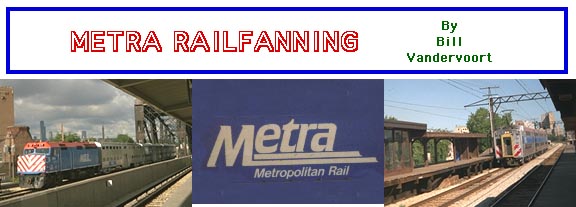
Visit this official Metra Web site for schedule and fare information.
Since 1984, the commuter rail system serving the Chicago area has been known as Metra. The Regional Transportation Authority (RTA) was formed in 1974 to coordinate and subsidize transit in the 6 county Chicago metropolitan area, and the RTA soon entered into "purchase of service contracts" with the private railroads operating the commuter trains. The RTA was reorganized in 1984, and Metra was created as the agency responsible for the commuter rail system.
Most of Metra's lines are named for the original operating railroads. Metra now directly operates all trains, except for the BNSF (Burlington Northern Santa Fe) line, and the Union Pacific (formerly the Chicago & North Western).
The Northern Indiana Commuter Transportation District (NICTD) in 1989 acquired the South Shore Line. This line opened in 1904 as the Chicago Lake Shore & South Bend Railroad, and was renamed in 1925 to the Chicago South Shore & South Bend Railroad. Metra is an agency within Illinois only, NICTD is the equivalent agency responsible for commuter trains in that part of Indiana.
This web site includes more timely information, on Metra operations.
Included are lists of stations, photos, crossings and junctions, mileposts, track diagrams, number of tracks, and signal systems.
The Weekend Pass is a great deal for railfans, allowing unlimited travel on all Metra lines on a Saturday and Sunday (not valid on South Shore Line).
The different railroads which evolved to today's Metra. Metra now directly operates some of its lines, while private railroads continue to have a role in the operation of many of Metra's services.
A brief history on what has remained a stable part of Chicago's transportation system, for more than 150 years.
Weekday timetables from the different commuter railroads serving Chicago, from various eras. Along with information on known commuter operations which were eventually discontinued.
A number of electric interurban railways also once existed in the Chicago area, with the South Shore Line the only interurban line remaining in America, having successfully evolved into a commuter rail line. Notable lines not to survive were the Chicago Aurora & Elgin Railroad, and the Chicago North Shore & Milwaukee Railroad, which had also prolonged their lives by functioning as commuter railroads. Several other interurban lines are only memories now. Most of the abandoned interurban rights of way have been made into trails, photographs are included showing remaining evidence of these past railroads.
GM-EMD F40PH and Motive Power MP36PH diesel locomotives and bilevel push-pull cars operate on most Metra lines. Electric multiple unit cars operate on the Metra Electric District and on the South Shore Line. Those lines are electrified at 1500 volts DC.
Until the late 1970's, most Chicago area commuter trains were powered by GM-EMD E-units and F-units. Although most of the former operating railroads modernized their commuter fleets with the bilevel cars still in service, some cars dating from the 1920's remained in commuter service into the 1970's.
A look at commuter railroad fares and ticketing, before and after the RTA fare unification of 1976.
Photos and tickets from Chicago's commuter railroads, prior to RTA and Metra unification.
Known discontinued commuter, suburban and neighborhood stations in Chicago and various suburbs.
Information contained on this site is unofficial. Any suggestions for additions and improvements to this site are welcome. Thanks for visiting! Bill Vandervoort
Go to
Chicago Transit & Railfan Web Site
